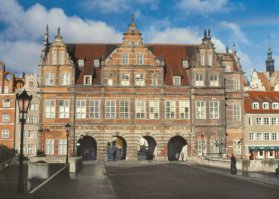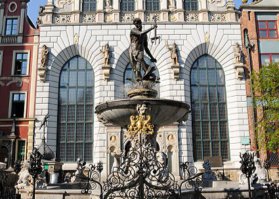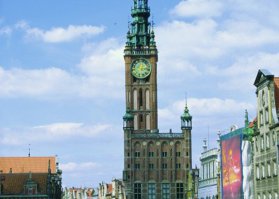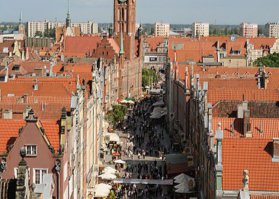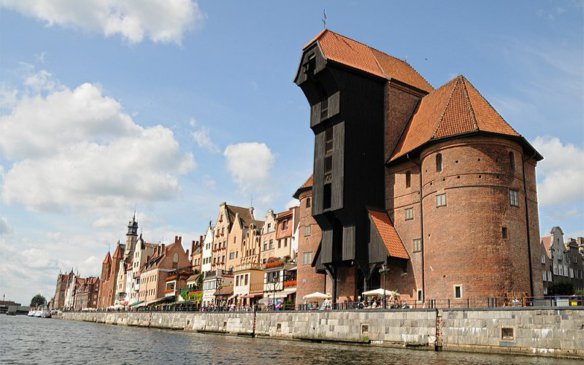

The Royal Route – the most popular tourist destination that thanks to Gdansk’s history, numerous historic monuments, its unique ambience and the music played by buskers is a must for any visitor to Gdansk.
The Royal Route took its name from the role it played in the past centuries. This used to be the way for the Polish royalty to enter the city. The royal entourage proceeded through the Upland Gate, and then through the Golden Gate opening onto Długa Street, where hours on end were spent entertaining the king with performances by tightrope walkers, street acrobats or with knights’ tournaments. It was here that kings listened to the city mayors’ welcome speeches.
The Royal Route takes visitors from the Upland Gate and the Prison Tower, through the Golden Gate up to the Green Gate seated by the Motlawa river. The Royal Route is lined all along with quaint historic town houses owned in the old times by Gdansk’s wealthiest citizens, mayors and merchants. Each of the houses has its own unique and rich history, secrets and legends.
As we walk onto the Royal Route, our attention is drawn by the Gothic and Renaissance building in the distance, adorned with an elegant clock tower. This is the Main Town Hall – the most significant secular building in old Gdansk. In the historic times, it was the seat of the city authorities and nowadays it is house to the Gdansk History Museum. Its interior – with the emblematic Great Council Hall, also known as the Red Chamber, is an example of one of the most opulent town hall interiors in modern history. The chambers, richly decorated with paintings by the most outstanding Dutch artists, with “The Apoteosis of Gdansk” taking the lead, each year attract hundreds of tourists willing to travel back in time, with the eyes of their imagination, to the age of the city’s splendour and prosperity.
Another highlight that catches the eye is the beautiful building of Artus’ Court, with Gdansk’s symbolic feature – Neptune’s Fountain – nestled right at its entrance. The figure of Neptune, the ancient Roman god of the seas and oceans, symbolizes the close ties between the city and the sea. The fountain is Gdansk’s major landmark and its most popular photo spot. There is a legend associated with the fountain that explains the invention of Gdansk’s famous liqueur called Goldwasser. The legend has it that centuries ago Neptune got upset about the coins that were thrown into the fountain and he struck his trident onto the water smashing the gold into fine flakes. Ever since that time golden flakes add glitter to this delicious root and herbal liqueur of Gdansk, which used to satisfy the palette of King Louis XVI of France and the Tsarina Catherine the Great of Russia. Until the present day, this beverage containing small flakes of 22 and 23 carat gold suspended in alcohol, is solely associated with Gdansk and represents its flagship product.
The name of the magic Artus’ Court is closely related to the legend of King Arthur and the Knights of the Round Table. In the historic times, the court provided an important venue for merchants, craftsmen, tradesmen and the wealthy residents of Gdansk who, similarly to the Knights of the Round Table, gathered in guilds. Artus’ Court played the role of an exclusive, high profile socializing venue for the local élite who, surrounded by its beautiful interior richly decorated with paintings and tapestries, entertained themselves with music and with a variety of acts from singers and jugglers. The most valuable part of the interior decoration, which enraptures with its artistic beauty, is the world’s largest ceramic-tiled stove, which is 11 metres high and weighs 13 tonnes and is covered with 520 colourful tiles.
The Green Gate, according to legend, took its name from the abundant seaweed and moss that used to densely cover its originally wooden structure, giving it its green colouring. The direct vicinity of the Motlawa river may attest to this story. The gate is one of Gdansk’s water gates and was designed as the royal residence for the Polish kings to stay during their visits to Gdansk. It also provided the main premises to the Nature Society and the Museum of Nature. Nowadays, one of its halls is the office of the former president of Poland and the co-founder of Solidarity – Lech Walesa.
We would like to recommend this short 900-metre itinerary abounding with Gdansk’s most important and beautiful historic monuments to all those who wish to see the very heart of historic Gdansk.
